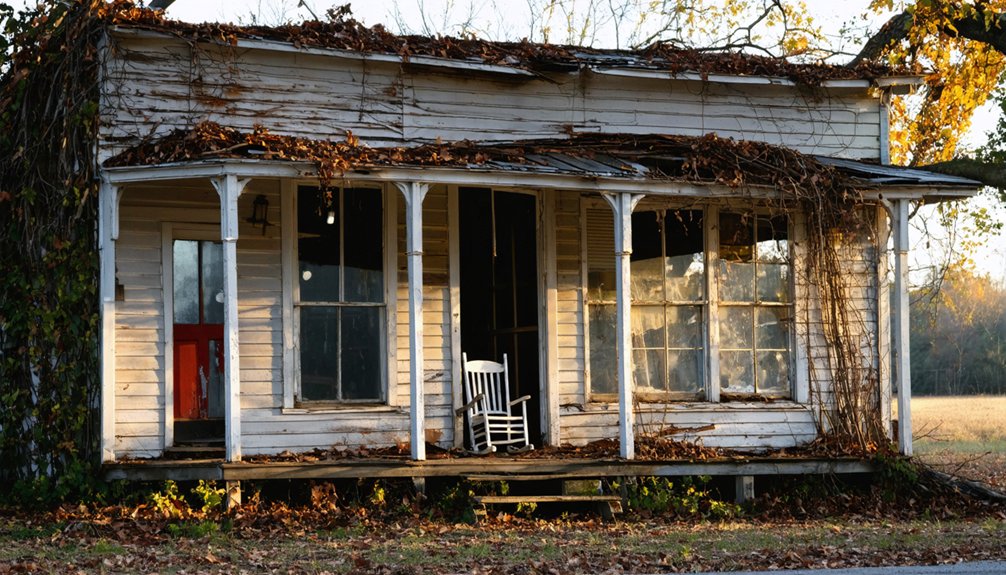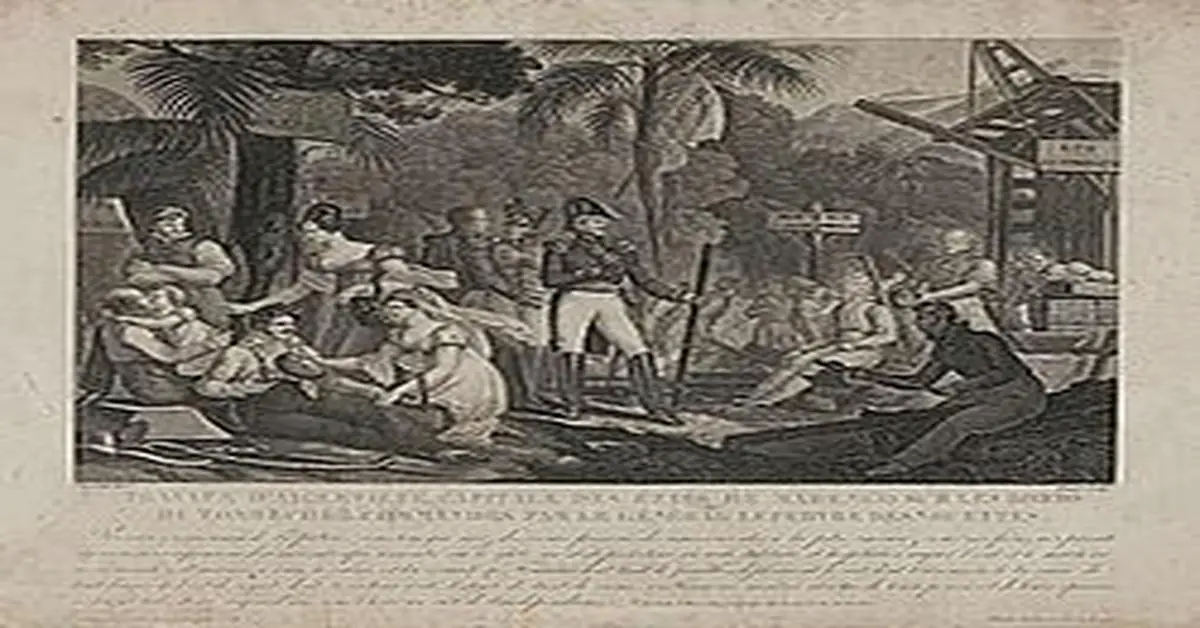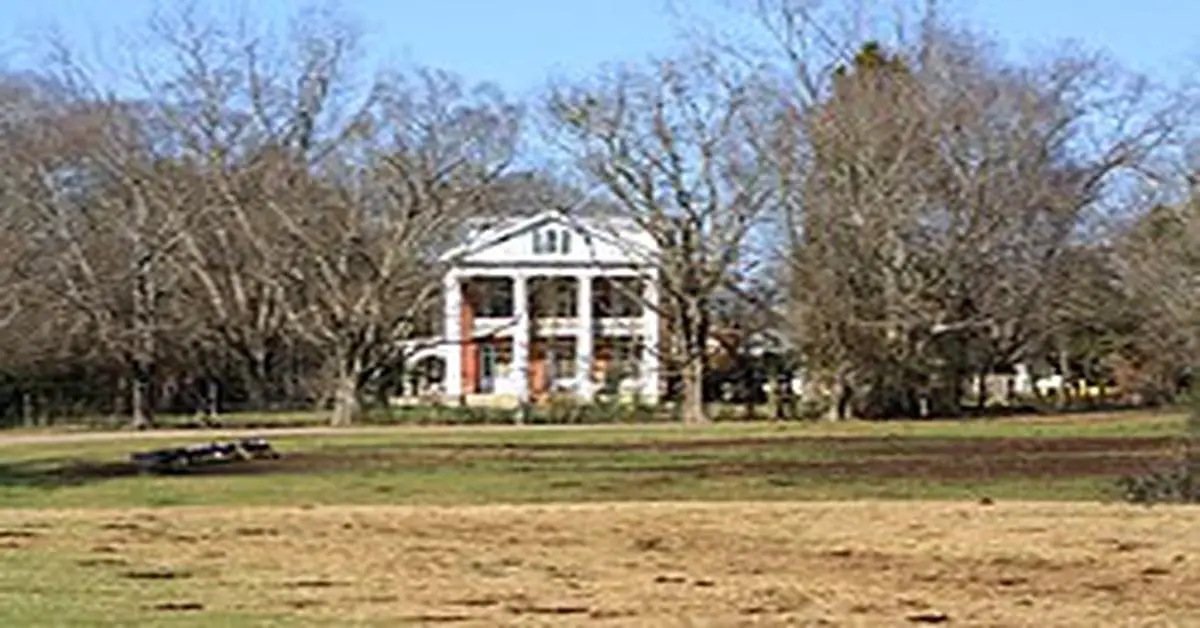You’ll find Dumphries, Alabama nestled in Washington County along the Tombigbee River, where it once flourished as an essential river commerce hub in the early 1800s. The town’s strategic location supported cotton trade, mining, and lumber processing until the Civil War disrupted its economic foundation. While nature has reclaimed most of the original settlement, scattered artifacts like glass fragments, ceramics, and mining equipment tell the story of this forgotten Black Belt community’s rise and fall.
Key Takeaways
- Dumphries was an early 19th-century river commerce hub in Washington County, Alabama, located at the junction of Tombigbee River and Bilbo Creek.
- The town’s economy centered on agricultural trade, particularly cotton shipments, mining activities, and lumber processing along the Tombigbee River.
- Civil War disruption and destruction of infrastructure led to the town’s decline, preventing recovery against regional competition and market changes.
- Archaeological evidence includes glass fragments, ceramics, mining tags, and lumber equipment, revealing the town’s industrial and cultural heritage.
- Nature has largely reclaimed the former town site, though scattered artifacts and historical records preserve its legacy as an Alabama ghost town.
The Birth and Peak of Dumphries (1819-1839)
While historical records about Dumphries, Alabama remain largely obscure, this ghost town‘s existence during the early 19th century marks an intriguing chapter in Alabama’s development.
The period between 1819 and 1839 represents a time of mystery in the settlement’s history, as details about its founding, economic activities, and social structures have been lost to time. Like nearby Old Cahawba, the town emerged during Alabama’s early statehood period. Located at Tombigbee River landing, Dumphries served as an important transportation point for the region.
Little is known about Dumphries during 1819-1839, as records of its establishment, commerce and community life vanished into history.
You won’t find documented evidence of the community dynamics that shaped daily life, nor records of the industries that might’ve driven its economy.
The town’s emergence coincided with Alabama’s early statehood, yet the specifics of its population growth, infrastructure development, and agricultural practices remain unknown.
The absence of historical data leaves us with more questions than answers about this enigmatic settlement.
Location and Geographic Features
Situated deep within Washington County in southwest Alabama, Dumphries once stood at the strategic junction of the Tombigbee River and Bilbo Creek, near what became known as Bilbo’s Landing.
You’ll find this ghost town‘s settlement patterns were shaped by the region’s natural features, including flat to gently rolling terrain and dense hardwood forests typical of the Gulf Coastal Plain.
The geographical significance of Dumphries centered on its prime location along the Tombigbee River, a major transportation artery that facilitated trade and movement throughout the area.
Like Blount Springs Alabama, which thrived as a popular resort destination in the 1830s, Dumphries capitalized on its waterfront location to attract visitors and commerce.
The landscape surrounding the settlement featured rich riverine systems and wetlands, while the broader region fell within Alabama’s historic Black Belt.
This strategic position at Bilbo’s Landing made Dumphries an essential point for river commerce and early American expansion.
Similar to Beaver Mills, the town became a vital commercial hub during the Civil War, serving as a supply depot for Confederate forces.
Economic Rise and Downfall
During its peak in the mid-1800s, Dumphries thrived as a bustling river commerce hub, drawing its economic strength from agricultural production and strategic trade positioning.
Similar to Cahaba’s success, the town primarily focused on cotton shipments during this period.
You’d have found a town leveraging its waterway access and road networks to establish essential trade routes with neighboring regions, while local farmers contributed to steady economic growth through livestock and crop production.
The Civil War struck a devastating blow to Dumphries’ prosperity.
You’ll find that the conflict disrupted established trade patterns and destroyed critical infrastructure.
Much like Cahaba’s experience, the region endured a devastating flood that further crippled recovery efforts.
In the war’s aftermath, the town struggled to recover as residents migrated away seeking better opportunities.
Despite reconstruction efforts and attempts to diversify the local economy, Dumphries couldn’t overcome the combined challenges of regional competition, shifting market demands, and the lasting impact of wartime destruction.
Life in Early Dumphries Settlement
As pioneers ventured westward in the early 1800s, Dumphries emerged from a wave of migration that brought settlers from South Carolina and Tennessee through Cherokee territory into Alabama. The area fell under Mississippi Territory jurisdiction until Alabama gained statehood.
You’d find these early settlers establishing farms near waterways, using basic tools to transform forested land into cultivated fields. Corn production began in 1816 as settlers worked to establish a local food supply.
Community interactions centered around shared labor and mutual support. You’d see families gathering for church services, community workdays, and trading activities.
Settlers relied on each other, coming together regularly for worship, shared work, and exchanging goods in their growing communities.
Agricultural techniques involved horse-drawn ploughs and manual tools, with settlers growing staple crops while raising livestock. They’d trade with neighboring Native American communities, particularly the Creek, Cherokee, and Choctaw peoples who maintained settlements along nearby waterways.
Life wasn’t easy – settlers faced health challenges like yellow fever and relied heavily on cooperation with neighbors for survival.
What Remains Today: A Ghost Town’s Legacy
While time has erased much of Dumphries’ physical presence, the ghost town’s legacy persists through scattered remnants and natural reclamation. You’ll find that nature has gradually reclaimed the area, similar to other Alabama ghost towns like Old Cahawba, where vegetation and wildlife now dominate former settlement grounds. Just as Old Cahawba served as Alabama’s first state capital from 1819 to 1826, these abandoned places offer invaluable insights into early settlement patterns.
Though specific details about Dumphries’ current state are limited, ghost town preservation efforts typically focus on protecting remaining structures and archaeological sites from environmental threats like flooding. Many communities like Dumphries saw their populations decrease to one fifth or less of their original size before being completely abandoned.
The site’s cultural heritage lives on through local folklore and historical documentation, even as physical evidence diminishes. While there’s no formal tourism program in Dumphries, other ghost towns in the region demonstrate how these historical sites can serve as powerful reminders of Alabama’s past, connecting you to stories of earlier settlements and their eventual decline.
Exploring Historical Records and Artifacts
You’ll find archaeological discoveries at Dumphries reveal typical 19th-century settlement patterns through building foundations, blacksmith tools, and household items.
Historical records and census data track the town’s population changes, particularly showing significant declines linked to regional epidemics and economic shifts.
Early written accounts from territorial records and personal documents provide essential insights into the daily operations and commercial activities that once defined this Alabama frontier town.
Archaeological Findings Today
Modern archaeological investigations of Dumphries reveal a scattered collection of artifacts typical of Alabama ghost towns, though specific findings remain limited.
You’ll find evidence primarily through mudlarking techniques along waterways and systematic metal detecting, which have uncovered glass fragments, ceramics, and metal objects dating from the late 19th to early 20th century.
Archaeological techniques focus on analyzing stratigraphic contexts, particularly near riverbanks and embankments where residents discarded household items.
Artifact preservation varies, but you can spot old foundations, depressions, and tree lines that hint at former property boundaries.
Industrial remnants like mining tags and lumber processing equipment suggest economic activities, while fragments of whiskey jugs and consumer products like ketchup bottles provide glimpses into daily life.
Most discoveries come from garbage heaps, which serve as time capsules of the community’s material culture.
Early Written Records Found
Although written records of Dumphries remain sparse, historical documents from Alabama’s territorial period provide essential insights into the town’s early development.
You’ll find evidence of the settlement’s historical significance in land grants, court documents, and newspaper archives that have survived through careful record preservation efforts.
Local historical societies maintain collections of early deeds and legislative records that tell the story of Dumphries’ establishment.
If you’re researching the town’s past, you’ll discover that colonial-era documents and territorial records offer glimpses into the daily lives of early settlers.
While accessing these materials can be challenging due to their age and fragile condition, digitization efforts are making more records available to researchers who want to understand this ghost town’s role in Alabama’s development.
Frequently Asked Questions
Are There Any Documented Paranormal Activities or Ghost Sightings in Dumphries?
You won’t find documented paranormal activities or ghost sightings here, as no official paranormal investigations or ghost tours have been conducted. Local legends might exist, but they’re not reliably recorded.
What Happened to the Original Residents After They Left Dumphries?
Persistent pioneers and original residents primarily pursued prospects in neighboring towns, though you’ll find no definitive documentation of their life after Dumphries, as migration records weren’t thoroughly maintained in that era.
Were There Any Notable Crimes or Scandals in Dumphries?
You won’t find any documented crimes or scandals in historical events connected to this place. Despite searching for unsolved mysteries, research shows no significant criminal incidents or notorious happenings there.
Did Any Famous Historical Figures Visit or Stay in Dumphries?
You won’t find verified records of famous visitors to Dumphries, as its historical significance remains largely undocumented. Without substantial research evidence, we can’t confirm any notable historical figures’ presence there.
What Indigenous Tribes Inhabited the Area Before Dumphries Was Established?
Along the fertile riverbanks where Dumphries would later stand, you’ll find rich tribal history of the Creek Indians, who were part of the powerful Creek Confederacy’s indigenous culture in Alabama.
References
- https://inspiredsoutherner.com/haunted-history-tour-lets-you-hunt-for-ghosts-in-old-cahawba/
- https://encyclopediaofalabama.org/article/cahaba/
- https://freepages.history.rootsweb.com/~gtusa/usa/al.htm
- https://www.tripadvisor.com/ShowUserReviews-g30754-d3405413-r702542512-Old_Cahawba_Archaeological_Park-Orrville_Alabama.html
- https://www.onlyinyourstate.com/trip-ideas/alabama/ghost-town-autumn-day-trip-al
- https://en.wikipedia.org/wiki/List_of_ghost_towns_in_Alabama
- https://www.islands.com/1829294/alabama-once-thriving-first-state-capital-cahawba-famous-abandoned-ghost-town-mysterious/
- https://ahc.alabama.gov/properties/cahawba/cahawba.aspx
- https://moonmausoleum.com/pegues-ghost-in-the-abandoned-antebellum-cahawba-town/
- https://digitalalabama.com/alabama-ghost-towns/blount-county-alabama-ghost-towns/47466


